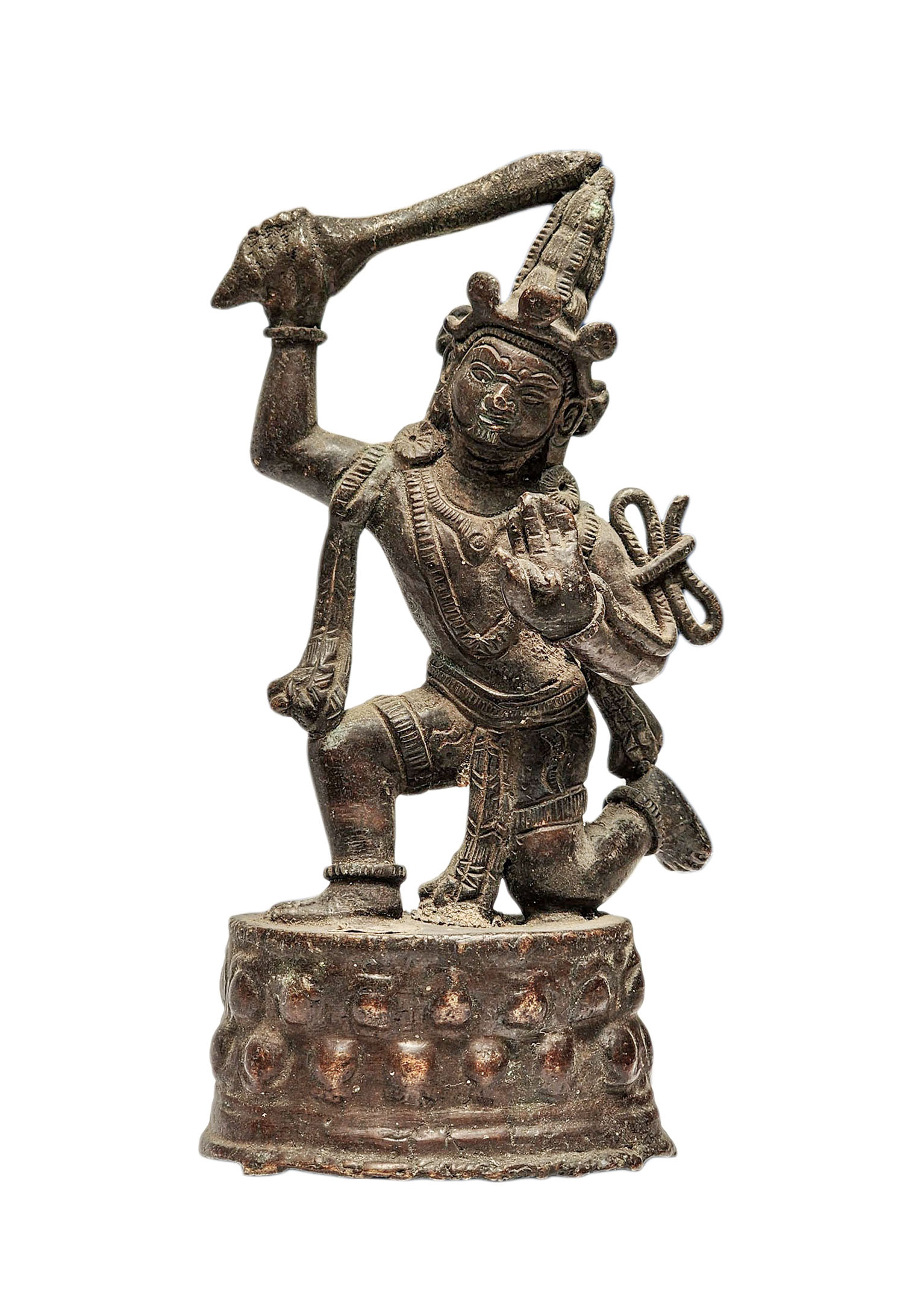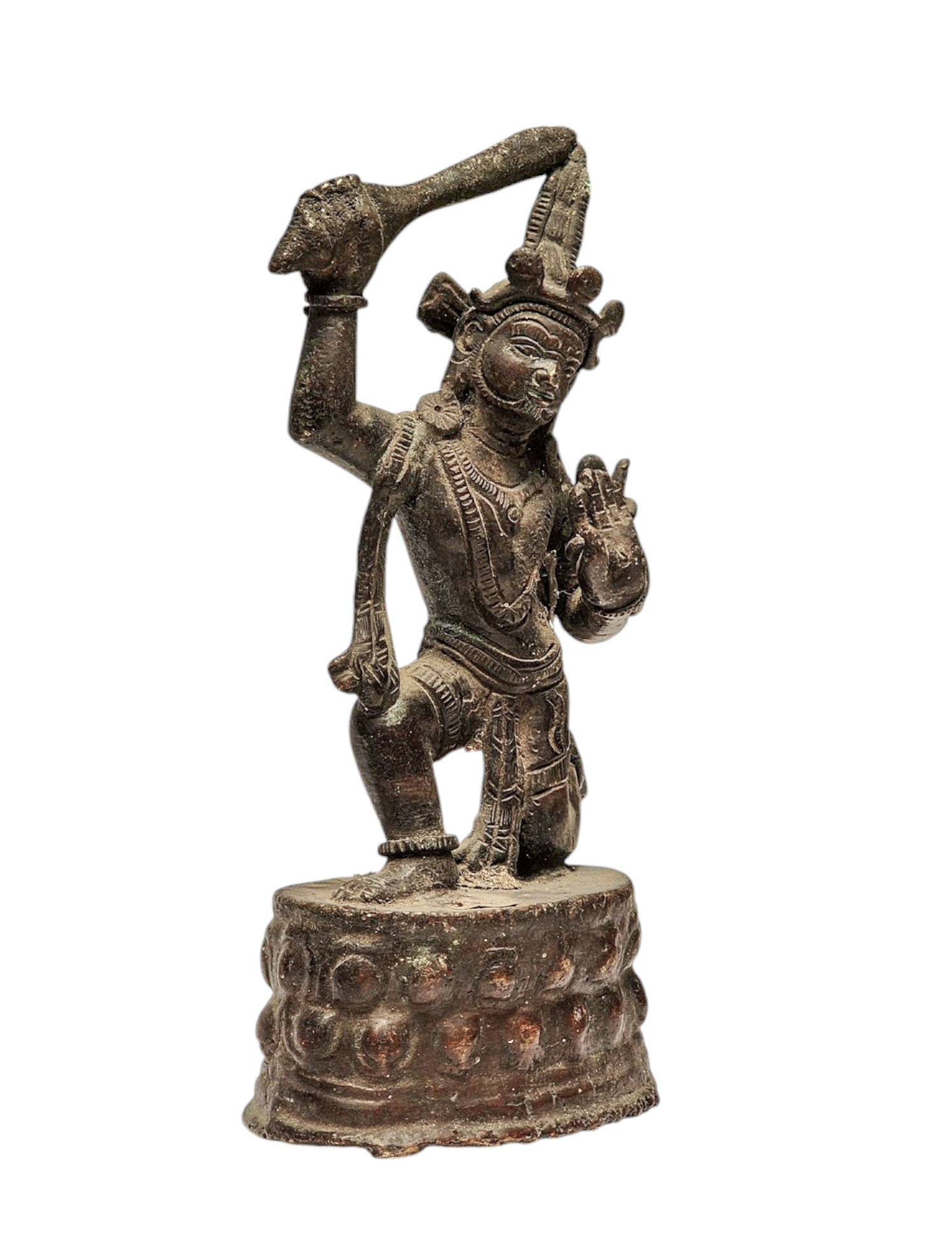Code
HCS26841
Weight
1.338 Kg / 2.95 lbs
Size
Height
10cm (4") Width
19cm (7") Depth
8cm (3") Material
Copper
Availability
Available

Safe Payment
We accept Paypal, Money Transfer, Bank Transfer
Confidence
Protection covers your purchase and personal data.
Worldwide Delivery
We ship Worldwide, except Russia.Shipping cost US$25.2 for upto 0.5 kgs

Hotline
Talk to help line for your question on 9841267335About Sacred Serenity Collection
This is a beautiful old Buddhist statue that carries a deep sense of spirituality and craftsmanship. These statues were made around 15 to 20 years ago and are crafted from pure copper. If the statue has gold, it has a thick layer of gold plating, unlike modern statues where using a lot of gold is expensive.
Skilled artisans, who were well-versed in religious teachings, made these statues. They followed traditional guidelines and sacred texts to create each statue with precise expressions and postures. The artisans believed they were creating representations of gods rather than just ordinary figures. This unique perspective is reflected in the statues themselves. Read More . . .
This is a beautiful old Buddhist statue that carries a deep sense of spirituality and craftsmanship. These statues were made around 15 to 20 years ago and are crafted from pure copper. If the statue has gold, it has a thick layer of gold plating, unlike modern statues where using a lot of gold is expensive.
Skilled artisans, who were well-versed in religious teachings, made these statues. They followed traditional guidelines and sacred texts to create each statue with precise expressions and postures. The artisans believed they were creating representations of gods rather than just ordinary figures. This unique perspective is reflected in the statues themselves. Read More . . .
Full Gold Gilded with Antique Patina.
The [old], Buddhist Handmade Statue Of Buddha Nirvana, [full Gold Plated], [antique Finishing] has full gold plated antique finishing. This finishing is a combination of fire mercury gold plating and antique finishing. This traditional technique involves the application of a genuine layer of gold onto the [old], Buddhist Handmade Statue Of Buddha Nirvana, [full Gold Plated], [antique Finishing] using the time-honored process of mercury gold plating. Skilled artisans meticulously handle the amalgamation of gold with mercury, ensuring precise application and a truly authentic result. To enhance its charm further, the [old], Buddhist Handmade Statue Of Buddha Nirvana, [full Gold Plated], [antique Finishing] undergoes an antique finishing process. This meticulous treatment adds a touch of age and character to the gold plating, creating a sense of antiquity. Through careful craftsmanship and the application of specialized techniques, the [old], Buddhist Handmade Statue Of Buddha Nirvana, [full Gold Plated], [antique Finishing] acquires a beautifully aged appearance that adds depth and uniqueness to its overall aesthetic. Read More . . .
The [old], Buddhist Handmade Statue Of Buddha Nirvana, [full Gold Plated], [antique Finishing] has full gold plated antique finishing. This finishing is a combination of fire mercury gold plating and antique finishing. This traditional technique involves the application of a genuine layer of gold onto the [old], Buddhist Handmade Statue Of Buddha Nirvana, [full Gold Plated], [antique Finishing] using the time-honored process of mercury gold plating. Skilled artisans meticulously handle the amalgamation of gold with mercury, ensuring precise application and a truly authentic result. To enhance its charm further, the [old], Buddhist Handmade Statue Of Buddha Nirvana, [full Gold Plated], [antique Finishing] undergoes an antique finishing process. This meticulous treatment adds a touch of age and character to the gold plating, creating a sense of antiquity. Through careful craftsmanship and the application of specialized techniques, the [old], Buddhist Handmade Statue Of Buddha Nirvana, [full Gold Plated], [antique Finishing] acquires a beautifully aged appearance that adds depth and uniqueness to its overall aesthetic. Read More . . .
Lost-Wax System
This Collection of [old], Buddhist Handmade Statue Of Buddha Nirvana, [full Gold Plated], [antique Finishing] is made by the process of the Lost Wax system. This is a very complicated, time consuming and historic process of making metal sculptures.Which is why it is sometimes called Precision Casting as well. Hence the sculptures made by this process are comparatively expensive. There are many new, advanced and less time consuming methods of casting metal sculptures available as well. But due to the benefits provided by the traditional lost wax system in quality control and customization, we prefer the Loss wax system over Ceramic molding, or sand casting to make our Collection.
Below we have tried to illustrate the process of making a loss wax system statue: Read More . . .
This Collection of [old], Buddhist Handmade Statue Of Buddha Nirvana, [full Gold Plated], [antique Finishing] is made by the process of the Lost Wax system. This is a very complicated, time consuming and historic process of making metal sculptures.Which is why it is sometimes called Precision Casting as well. Hence the sculptures made by this process are comparatively expensive. There are many new, advanced and less time consuming methods of casting metal sculptures available as well. But due to the benefits provided by the traditional lost wax system in quality control and customization, we prefer the Loss wax system over Ceramic molding, or sand casting to make our Collection.
Below we have tried to illustrate the process of making a loss wax system statue: Read More . . .
Brief Introduction :
Nirvana (Sanskrit: nirvāṇa; Pali: nibbana, nibbāna) is the goal of the Buddhist path. The literal meaning of the term is "blowing out" or "quenching". Nirvana is the ultimate spiritual goal in Buddhism and marks the soteriological release from rebirths in saṃsāra. Nirvana is part of the Third Truth on "cessation of dukkha" in the Four Noble Truths, and the summum bonum destination of the Noble Eightfold Path.
In the Buddhist tradition, nirvana has commonly been interpreted as the extinction of the "three fires", or "three poisons",[note 1] greed (raga), aversion (dvesha) and ignorance (moha). When these fires are extinguished, release from the cycle of rebirth (saṃsāra) is attained.
Nirvana has also been claimed by some scholars to be identical with anatta (non-self) and sunyata (emptiness) states though this is hotly contested by other scholars and practicing monks.[web 1] In time, with the development of the Buddhist doctrine, other interpretations were given, such as the absence of the weaving (vana) of activity of the mind, the elimination of desire, and escape from the woods, cq. the five skandhas or aggregates.
Buddhist scholastic tradition identifies two types of nirvana: sopadhishesa-nirvana (nirvana with a remainder), and parinirvana or anupadhishesa-nirvana (nirvana without remainder, or final nirvana). The founder of Buddhism, the Buddha, is believed to have reached both these states.
Nirvana, or the liberation from cycles of rebirth, is the highest aim of the Theravada tradition. In the Mahayana tradition, the highest goal is Buddhahood, in which there is no abiding in nirvana. Buddha helps liberate beings from saṃsāra by teaching the Buddhist path. There is no rebirth for Buddha or people who attain nirvana. But his teachings remain in the world for a certain time as a guidance to attain nirvana.
Nirvana has also been claimed by some scholars to be identical with anatta (non-self) and sunyata (emptiness) states though this is hotly contested by other scholars and practicing monks.[web 1] In time, with the development of the Buddhist doctrine, other interpretations were given, such as the absence of the weaving (vana) of activity of the mind, the elimination of desire, and escape from the woods, cq. the five skandhas or aggregates.
Buddhist scholastic tradition identifies two types of nirvana: sopadhishesa-nirvana (nirvana with a remainder), and parinirvana or anupadhishesa-nirvana (nirvana without remainder, or final nirvana). The founder of Buddhism, the Buddha, is believed to have reached both these states.
Nirvana, or the liberation from cycles of rebirth, is the highest aim of the Theravada tradition. In the Mahayana tradition, the highest goal is Buddhahood, in which there is no abiding in nirvana. Buddha helps liberate beings from saṃsāra by teaching the Buddhist path. There is no rebirth for Buddha or people who attain nirvana. But his teachings remain in the world for a certain time as a guidance to attain nirvana.
How did Gautama Buddha reach Enlightenment (Nirvana)?


![[old], Buddhist Handmade Statue Of Buddha Nirvana, [full Gold Plated], [antique Finishing]](https://handicraftseller.com/uploads/pics/product/thumb/2022/11/26841.jpg)
![[old], Buddhist Handmade Statue Of Buddha Nirvana, [full Gold Plated], [antique Finishing]](https://handicraftseller.com/uploads/pics/product/thumb/2022/11/26841_0.jpg)


























































 + 50 Year Old Buddhist Miniature Statue
+ 50 Year Old Buddhist Miniature Statue  + 50 Year Old Buddhist Miniature Statue
+ 50 Year Old Buddhist Miniature Statue  Old Stock, Buddhist Statue
Old Stock, Buddhist Statue  Old Stock, Buddhist Statue
Old Stock, Buddhist Statue  Old, Buddhist Handmade Statue
Old, Buddhist Handmade Statue  Old, Buddhist Handmade Statue
Old, Buddhist Handmade Statue  Old, Buddhist Handmade Statue
Old, Buddhist Handmade Statue  Old, Buddhist Handmade Statue
Old, Buddhist Handmade Statue  Old Stock Buddhist Statue
Old Stock Buddhist Statue  Old Stock Buddhist Statue
Old Stock Buddhist Statue  Old Stock, Nepali Handmade Statue
Old Stock, Nepali Handmade Statue  Old Stock, Nepali Handmade Statue
Old Stock, Nepali Handmade Statue  Old, Buddhist Statues
Old, Buddhist Statues  Old, Buddhist Statues
Old, Buddhist Statues  of Maya Devi,
of Maya Devi,  of Maya Devi,
of Maya Devi,  Old Stock, Last Piece, Statue White Mahakala
Old Stock, Last Piece, Statue White Mahakala  Old Stock, Last Piece, Statue White Mahakala
Old Stock, Last Piece, Statue White Mahakala  Old Stock, Mahakala Twelve Arms Statue, A Buddhist Handmade Statue, Gold Plated, Face Painted,
Old Stock, Mahakala Twelve Arms Statue, A Buddhist Handmade Statue, Gold Plated, Face Painted,  Old Stock, Mahakala Twelve Arms Statue, A Buddhist Handmade Statue, Gold Plated, Face Painted,
Old Stock, Mahakala Twelve Arms Statue, A Buddhist Handmade Statue, Gold Plated, Face Painted,